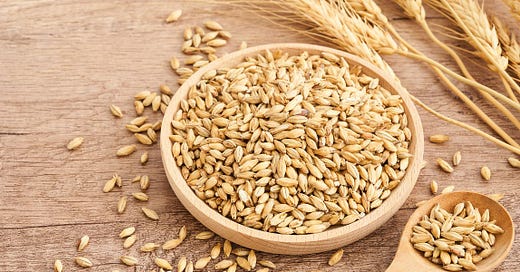Broccoli Rising and Totally Vulgar
We’re all vulgar. Oh, honey, I don’t mean you personally, I mean hordeum vulgare, better known as barley. At a time when we’re deeply divided, barley reminds us of all we have in common, and offers whole grain goodness* too.
Barley began the same place we did — in the Fertile Crescent — it had nice weather, lush land, and fresh water. Humans settled here around 11,000 BCE, We started cultivating barley, one of the oldest of the ancient grains, soon after. Not a coincidence. Having access to nourishing food does have a positive civilizing influence.
With civilization comes style, and barley played a role there too. Archaeologists have found mummies buried with necklaces of barley grains — that’s how precious it was. Barley might have served the elite ancient Egyptians as a must-have fashion accessory, but for the rest of us, it’s been a sustaining staple crop for millennia. In the Bible, the Promised Land is portrayed as “a land of wheat, and barley, and vines, and fig trees and pomegranates; a land of olive oil and honey.” Together, they comprise Judaism’s seven sacred foods.
From our beginnings in Egypt, Israel and elsewhere along the Fertile Crescent, humanity spread out all over creation. So did barley. Figs, dates and olives can be all but impossible to grow in some regions, but barley thrives wherever we do.
In Ethiopia, barley is known as gebs ye ehil nigus, king of crops, because it feeds so many people and happily grows in so many environmental conditions. Barley should be king of the world in that regard. It’s a sustainability superhero, a non-fussy, low-water crop with a high yield, able to grow in almost every climate and country.
Barley grows where it’s hot — Africa, Australia, the Andes, and even here in Florida, thanks to climate change. Barley also grows where it’s cool and damp, be that Ireland, Tibet, or Norway, where it’s the country’s most cultivated crop.
Barley can feed the world. It quenches our thirst too. Can’t have beer without barley. The variety of barley you might eat in Norway may have evolved and adapted to the region so it’s not quite the same barley grown in Florida, but it’s still barley.
To put this to the test, I reached out to @ArcticGrub’s Sunny Gandara. Sunny’s recipes take traditional Nordic cuisine and ingredients and present them with a plant-based spin. She’s vegan. So am I. We both lost our beloved dogs at close to the same time, a loss Sunny’s taken so to heart, she’s become a certified pet nutritionist. I asked if she’d share a Nordic barley recipe. She created a winner, with fresh cucumber and dill — cooling produce that just screams Scandinavian. In turn, I’ve created an original barley recipe also designed to keep you cool in this summer heat, but this one uses tropical fruits and flavors from my neck of the woods. Paid subscribers, scroll down to the bottom for both recipes, eat up and enjoy.


And for all Broccoli Rising subscribers,
A Handful of Barley Recipes From All Over the World
A few from the Fertile Crescent, where it all began:
Judaism’s seven sacred foods come together in another great, grainy salad
Barley cooks up into a fantastic Egyptian breakfast porridge
Moving on to Ethiopia, where barley’s a munchy snack called kolo
Ireland, with its many shades of green, inspired this wild greens and barley recipe. If you don’t get into greens like I do, cheer up — cooking them with barley or other whole grains dials down their vibrant flavor and texture.
I created this smoky barley stew recipe after enjoying something similar in Vienna.
Of course there’s mushroom barley soup, a comforting classic from Central and Eastern Europe.
Zoom with me back down to the tropics, where the Whole Grains Council treats barley to the flavors and fruits of Latin America.
There’s a world of barley, and we can adapt right along with it. As our population grows and our natural resources dwindle, we’re going to need every inch of arable land to grow food. We’re devoting three-quarters of land for livestock production. Imagine if we used that land for growing barley and other crops. There’d be plenty of food for everyone. Eating less meat and more barley, beans and produce might be what saves us. Y’all remember Charles Darwin, right? It’s adapt or perish. Adaptation’s a much better choice.
Like barley, we’re all connected, even when we insist on our differences. There’s a lot to love about being vulgar.
*Okay, you got me on a technicality. When we’re talking whole grains, we mean complete grains, with their hull or husk, their protective outer coat intact. However, barley’s a tough case. Literally, Whole grain barley, sometimes known as pot barley, has a husk that’s thick, and not terribly delicious or digestible. It also takes up to an hour to cook on the stovetop. Pearl barley, the kind in the recipes shared here, comes with the husk removed. It’s still plenty fiber-rich, out-fibering almost all the other whole grains, lowering cholesterol and managing blood sugar, but it cooks in half the time. It’s chewy, nutty-tasting, and high in protein, minerals and B vitamins. Yay.
You can get access to full recipes on a regular basis with a paid subscription. Not a paid subscriber yet? No problem! Join now to enjoy exclusive content like the recipes below and much more.
Not quite ready to upgrade to be a paid subscriber but want to support Broccoli Rising? Adding to my tip jar helps keep me in broccoli and beans. I’m madly grateful. Thanks.
Thanks to you all for reading and subscribing. This issue of Broccoli Rising is free. Please spread the broccoli love and share.
You can also visit SoulfulVegan.com to find more recipes and connect with me online at YouTube, Instagram, Twitter and Substack Notes.






